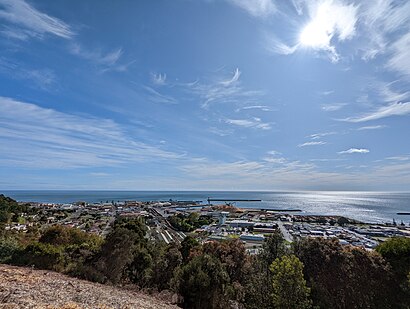Directions to Burnie (Burnie - Pt A) with public transport
The following transport lines have routes that pass near Burnie
How to get to Burnie by bus?
Click on the bus route to see step by step directions with maps, line arrival times and updated time schedules.
Bus stops near Burnie in Burnie - Pt A
- Stop 1, No.2 Aileen Cres (Corner Mount St), 7 min walk,
- Stop 32, No.171 Mount St, 8 min walk,
- Stop 32, 204a Mount St, 8 min walk,
- Wilson St (Elphinstone Gate 2), 10 min walk,
Bus lines to Burnie in Burnie - Pt A
- 196, Burnie Via Hillcrest,
- 191, Emu Heights,
- 192, Acton Via Upper Burnie (On To Montello),
- 194, Shorewell Pk Via Upper Burnie (Circular),
- 193, Burnie City Via Upper Burnie (Circular),
- 195, Burnie City Via Upper Burnie (Circular),
- 190, Ulverstone Via Penguin & Wivenhoe,
What are the nearest stations to Burnie?
The nearest stations to Burnie are:
- Stop 1, No.2 Aileen Cres (Corner Mount St) is 498 meters away, 7 min walk.
- Stop 32, No.171 Mount St is 520 meters away, 8 min walk.
- Stop 32, 204a Mount St is 527 meters away, 8 min walk.
- Wilson St (Elphinstone Gate 2) is 715 meters away, 10 min walk.
Which bus line stops near Burnie?
194 (Shorewell Pk Via Upper Burnie (Circular))
What’s the nearest bus station to Burnie in Burnie - Pt A?
The nearest bus station to Burnie in Burnie - Pt A is Stop 1, No.2 Aileen Cres (Corner Mount St). It’s a 7 min walk away.
What time is the first bus to Burnie in Burnie - Pt A?
The 195 is the first bus that goes to Burnie in Burnie - Pt A. It stops nearby at 09:22.
What time is the last bus to Burnie in Burnie - Pt A?
The 194 is the last bus that goes to Burnie in Burnie - Pt A. It stops nearby at 18:18.
See Burnie, Burnie - Pt A, on the map
Public Transit to Burnie in Burnie - Pt A
Wondering how to get to Burnie in Burnie - Pt A, Australia? Moovit helps you find the best way to get to Burnie with step-by-step directions from the nearest public transit station.
Moovit provides free maps and live directions to help you navigate through your city. View schedules, routes, timetables, and find out how long does it take to get to Burnie in real time.
Looking for the nearest stop or station to Burnie? Check out this list of stops closest to your destination: Stop 1; Stop 32; Stop 32; Wilson St (Elphinstone Gate 2).
Bus: 194, 196, 191, 192, 193, 195, 190.
Want to see if there’s another route that gets you there at an earlier time? Moovit helps you find alternative routes or times. Get directions from and directions to Burnie easily from the Moovit App or Website.
We make riding to Burnie easy, which is why over 1.5 million users, including users in Burnie - Pt A, trust Moovit as the best app for public transit. You don’t need to download an individual bus app or train app, Moovit is your all-in-one transit app that helps you find the best bus time or train time available.
For information on prices of bus, costs and ride fares to Burnie, please check the Moovit app.
Use the app to navigate to popular places including to the airport, hospital, stadium, grocery store, mall, coffee shop, school, college, and university.
Burnie Address: Upper Burnie TAS 7320 street in Burnie - Pt A

Places Near Burnie (Burnie - Pt A)
How to get to popular places in Launceston and Burnie with public transport
Get around Burnie - Pt A by public transport!
Travelling around Burnie - Pt A has never been so easy. See step by step directions as you travel to any attraction, street or major public transport station. View bus and train timetables, arrival times, service alerts and detailed routes on a map, so you know exactly how to get to anywhere in Burnie - Pt A.
When travelling to any destination around Burnie - Pt A use Moovit's Live Directions with Get Off Notifications to know exactly where and how far to walk, how long to wait for your line , and how many stops are left. Moovit will alert you when it’s time to get off — no need to constantly re-check whether yours is the next stop.
Wondering how to use public transport in Burnie - Pt A or how to pay for public transport in Burnie - Pt A? Moovit public transport app can help you navigate your way with public transport easily, and at minimum cost. It includes public transport fees, ticket prices, and costs. Looking for a map of Burnie - Pt A public transport lines? Moovit public transport app shows all public transport maps in Burnie - Pt A with all bus routes and stops on an interactive map.
Launceston and Burnie has 1 transport type(s), including: bus, operated by several transport agencies, including Metro Tasmania - Launceston, Tassielink, Metro Tasmania - Burnie, Lee's Coaches, Manion's Coaches, Mersey Link and Redline Coaches
